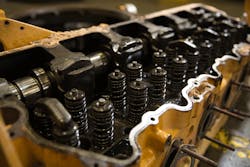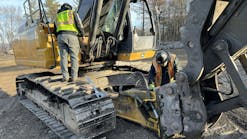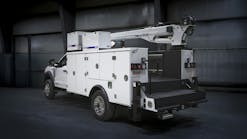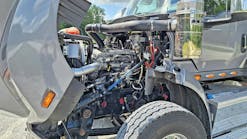When acquiring a piece of construction equipment, many equipment managers ask dealers one common question: How long will the engine run before a rebuild is needed?
“The powertrain is on many of our customers’ minds, even at the time of purchase,” says Scott Tolley, product support sales specialist for Foley Equipment, a Caterpillar dealer based in Wichita, Kansas, who has been involved in many powertrain rebuilds over the years.
This article was supplied by Caterpillar.
That can be a loaded question, as there are many variables in determining how long an engine will last. From the basics of how well the engine is maintained and if spec replacement filters are used to the engine’s workload and idle time, this component’s first life can greatly vary.
For fleet management purposes, manufacturers such as Caterpillar and its authorized dealers such as Foley Equipment have developed a fuel burn rule-of-thumb to give a customer an idea of how long an engine should last before needing to be rebuilt.
“Some try to ballpark engine hours,” says Trent Simpson, product manager for Cat Reman engines and components, “but that can vary, based on workload. The harder a machine works, the more fuel consumed and the sooner the engine will need to be rebuilt, so fuel burn is a better indicator for engine life.”
Although contingent upon multiple external factors, the fuel burn rule-of-thumb calculation multiplies engine liter size by 10,000 gallon of fuel burned. Using this rule of thumb, a fleet manager could expect to rebuild the 15-liter Cat C15 engine powering a Cat D8 dozer after burning about 150,000 gallons of fuel.
Scott Harmon, senior parts & service marketing consultant-Cat Reman sales and marketing, says there is a sweet spot for rebuilding.
“For the 15-liter engine, a contractor should plan for a rebuild somewhere in between 150,000 to 180,000 gallons of fuel burned,” he says. “That’s not saying the engine must be rebuilt during this window, but the longer it is pushed beyond this sweet spot, the increased risk of parts being damaged beyond reuse guidelines and requiring replacement, which increases the cost of the rebuild.”
He also describes a “bathtub” engine failure curve common to any type or brand of machinery. If a new piece of construction equipment experiences an engine failure, it will be soon after delivery. The curve then decreases and bottoms out through the engine’s expected service life before another rise is experienced as the engine approaches its first rebuild. “The optimum time to lower engine rebuild cost is when a contractor starts seeing problem indicators toward the end of its first life,” Harmon says.
Contractors have several tools at their disposal to pick up on problem indicators that, if not addressed, could cause a variance in the rule of thumb and increase engine rebuild costs. Today’s electronic engines, assisted by telematics, help to track fuel consumption and help to identify several engine problem indicators. The operator can also help by noticing an increase of fuel consumption, while machine performance is on the decline. Another problem indicator, machine vibration will start to increase, possibly rattling off mounted machine components.
Fluid sampling via services like Cat S∙O∙S Services will also start showing signs of internal issues. For example, samples showing increased silica in the oil indicate dust particles are passing through a potentially clogged air filter. Metal shavings indicate bearing wear.
Although the sweet spot for a 15-liter engine may be between 150,000 to 180,000 gallons of fuel burned, some contractors try to push beyond the threshold before rebuilding as a fleet management strategy or timing need. Others may just push the engine to failure. “We always caution customers who are tempted to push an engine to its service life limits to consider the cost of downtime,” says Tolley.
It’s important to have the conversation with the dealer when purchasing the equipment to let the representative know your end goals.
“We can help a contractor get the most out of an engine and machine, but we need to know the fleet management strategy,” Tolley says.
Tolley also cautions that the longer a contractor pushes an engine beyond the sweet spot and more problem indicators are ignored, the costlier the fix. These warning signs show that the wear parts are failing to do their job of protecting costlier engine components. “When parts like rocker arms, pistons and crankshaft are damaged, the rebuild costs significantly increase or a new engine may be needed,” he adds.
How to rebuild engines life and investment
Although there are many variables impacting engine life, the bottom line is the better operated and maintained engine will last longer. Using the manufacturer-specified filters and fluids go a long way in extending engine life, as do following daily inspections, adhering to maintenance schedules, and addressing issues at the onset.
Operator training also factors into extending engine life. In the same machine performing the same application, a less experienced operator can burn through more fuel per hour than one with more training. “This is where monitoring fuel consumption through a telematics solution like Cat Product Link, which can be viewed through the Cat App or VisionLink, can be of great value. It can help determine if an operator needs more training,” says Tolley.
Small, easy-to-clean and replaceable items such as an air filter can significantly impact engine life and operating costs. A plugged filter allows dust particles to pass into the engine and remove the cylinder liner crosshatch, increasing engine blow-by oil consumption. “Dust particles in the engine is like sanding the cylinder liner with 400-grit sandpaper, and a dusted engine is costly to fix,” says Harmon.
Fluid sampling gives equipment owners and fleet managers a valuable glimpse into the lifeblood of the machine. This simple diagnostic helps to determine if the engine is in good health or if larger issues are looming.
“If the fluid sampling shows fuel getting into the oil, a fuel injector is failing,” says Tolley. “It’s an easy fix that if not quickly addressed can turn into a much costlier, premature component failure.”
Customer Value Agreements (CVAs) and other manufacturer protection plans are gaining traction with contractors to offer a second set of eyes from the dealer to address small items and should help extend engine service life. Contracts with dealers can be customized to include condition monitoring, maintenance agreements, fluid sampling, and other items.
“The contractor’s business is to move dirt or complete whatever task is required within its line of work,” says Tolley. “The dealer’s business is helping to take care of the machine, and, in doing so, we can help to lower operating costs.”
The time a machine will hit the rule-of-thumb sweet spot of fuel burn before engine rebuilding varies by, among other things, job type. Contractors consistently working the engine at load on a pipeline project will most likely reach that sweet spot sooner than most machines working in the public sector, which typically log higher engine idle time.
Both Harmon and Tolley recommend keeping the idle time to a minimum to boost engine longevity and lower costs.
“Roughly 80 percent of operating costs are attributed to fuel expense, so whatever you can do to save fuel would help to increase profitability” says Harmon. “Plus, engines are designed to work at load, so idling is the worst thing for the engine,” says Harmon.
Tolley adds: “If a company logs 50 percent idle time, think about how much preventative maintenance you are doing without making any money after 10,000 operating hours.”
Finding that sweet spot, the better maintained engine will be less costly and less time-consuming to rebuild. Tolley mentions the typical engine rebuild takes two to three weeks, but “it can be done faster, if planned and executed properly,” he says.
These lower costs are attributed to Level 1 wear-item parts like seals and gaskets, designed to protect the more expensive components, being replaced at recommended intervals or at the first sign of trouble. This enables more Level 2 parts like pistons and injectors that wear at a slower rate to be reused at a rebuild interval.
“Caterpillar offers dealers detailed reuse and replace guidelines to help identify which items can be reused or reconditioned to help further save money on the rebuild,” says Simpson.
Additionally, the contractor should not have to worry about replacing the Level 3 parts like block castings and crankshafts, since they are designed to last the lifetime of the machine unless there is a catastrophic failure. “When you start replacing Level 3 parts, that’s when rebuild cost escalates,” says Harmon.
For parts that cannot be reused, one way to cut rebuild time nearly in half while keeping costs to a minimum, is to use remanufactured parts from the manufacturer. These parts simply slip into their place. Most manufacturers do a high volume of component remanufacturing, so they can often do it more quickly and at a lower cost than the contractor. “It’s generally about 60 percent the cost of new to rebuild an engine using remanufactured components,” says Simpson.
If a part cannot be reused and a remanufactured alternative is not available, Harmon recommends customers go with genuine OEM parts.
“It negatively affects overall system efficiency when not using the specified OEM part,” he says. This is because will-fit parts are made to fit, yet they have not been developed to operate as part of the manufacturer’s overall system components. They might not be built to the same standards or offer the same tolerances, which is critical with high-load components like the engine.
As an interim step between OEM and will-fit parts, some manufacturers now offer a value line of replacement parts, like Caterpillar’s Yellowmark. These parts are built to the same tolerances and work as part of the adjoining system components, unlike some will-fit parts. Although typically offering some kind of warranty, the flip side to value parts is they may not offer as much durability or as long of a service life as the genuine OEM part.
Simpson says contractors using remanufactured parts from the manufacturer to rebuild an engine will also receive some sort of warranty.
“Caterpillar offers a one-year warranty to back its Cat reman components, the same warranty as new parts, to give contractors a little extra assurance,” he says. Even better, he says, the contractor should expect to receive another full life from the completed rebuilt engine.






